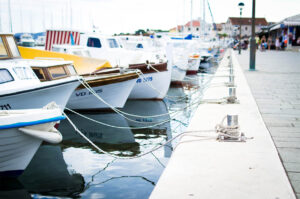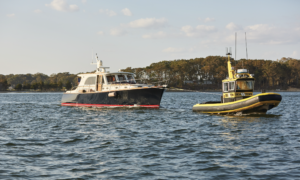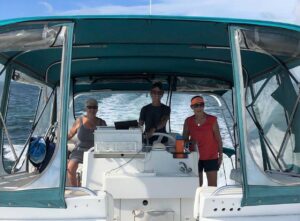Seasickness is a wicked spirit, always haunting those of us who love the sea. I’ve seen it make grown men crawl into a fetal position and cry for their mothers to relieve their wretched misery.
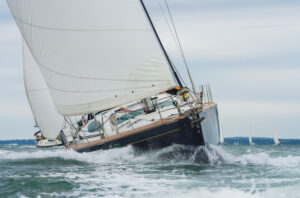
The insidious condition we know as seasickness is not limited to the motion of the ocean. It can come from any similar type of movement, be it the back seat of a car, airplane turbulence or the Tilt-A-Whirl ride at a summer carnival. Seasickness is the earliest known form of motion sickness, which was well documented by the Greeks and Romans. The word “nausea” comes from the Greek word “naus,” an ancient type of sailing ship.
Seasickness results when conflict occurs between what your inner ear senses and your eyes see. Inside your ears are three tiny semicircular fluid-filled canals, part of the vestibular system. When your body experiences motion, liquid inside the canals moves around interacting with tiny hairs lining each canal. These hairs translate the movement of the liquid into nerve messages that are sent to your brain. The brain reads these signals and compensates with counter movement, enabling you to keep your balance when moving.
When you are inside a boat or reading in the backseat of a car, your ears sense the motion, but your eyes don’t register movement, because what you see is moving with you. Your brain responds with a series of stress-related symptoms such as profuse sweating, chills, nausea, vertigo and vomiting. But why vomiting? What’s up with this business of throwing up when your internal sensors are conflicted with different signals of movement? Would you believe it was once meant to keep you alive?
Thousands of years ago when humans lived in small hunter/gatherer societies, people foraged for part of their diet. Beyond watching what animals ate and avoided, finding safe food was largely trial and error. Many poisonous fruits and berries had a hallucinogenic effect, causing dizziness and disorientation.
It’s theorized that when people ate poisonous berries, their bodies attempted to save them by expelling the poison. Even though you may not forage for food anymore, your body has retained that life-saving response. Motion sickness mimics that disoriented feeling of ingesting poison, and vomiting is your body reacting to those ancient memories by trying to expel it.
A curious thing about seasickness is the varying degree to which people are affected, with some more susceptible than others. It is certain that everyone with a working vestibular system is capable of suffering from some type of motion sickness. If you boat long enough, you will fall into one of two categories: those who have been and those who will be seasick.
Underlying the sweating and vomiting phase of seasickness is a little known and potentially more pernicious type of seasickness, called Sopite syndrome. As reported by Dr. James R. Lackner in an article for the National Center for Biotechnology Information, sopite syndrome comes from the Latin word “sopire” which means to “lull” or “put to sleep.” It differs from the more common motion sickness symptoms and may occur before the onset of other symptoms.
Some of the first symptoms of sopite syndrome could be yawning, drowsiness, apathy and decreased ability to concentrate, among others. These symptoms may exist in addition to nausea and may persist. According to Sigurd W. Hystad, in a paper published in Safety and Health at Work, boaters underway for extended periods of time are especially susceptible to sopite syndrome. Hystad claims, “Noise within the vessel, vibration caused by the engine and motion caused by harsh weather are all known to be significant stressors that can lead to sopite syndrome.”
Prevention over Cure
It’s well known that looking at the horizon or out the window causes the feelings to subside. The reason for this relief is that you’ve eliminated the conflict. Your ears still sense the motion, but by looking at a stationary object in the distance, your eyes now validate what your ears are sensing, and all your systems get green lights.
Unfortunately, boaters don’t often seek relief until they already feel the effects, and this may be too late. Once your brain thinks it needs to save you by giving up your breakfast, you may have a hard time talking that back down. It’s more effective to stop it from happening in the first place, than to address symptoms once they begin.
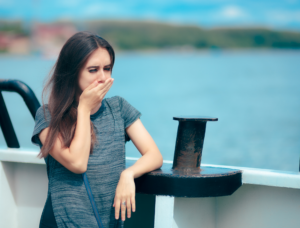
Numerous over-the-counter drugs are available that intend to minimize motion sickness symptoms such as dimenhydrinate (Dramamine), meclizine (Bonine), cinnarizine (Stugeron), along with the prescription drug scopolamine, but most have negative side effects. For centuries sailors have used non-pharmaceutical solutions like ginger, which is well known to quiet an upset stomach.
Chewing gum is also beneficial, but curiously, research has shown that it doesn’t appear to be the gum that makes the difference; it seems to be just the act of chewing. Acupressure bands strategically placed on the wrist have also proven effective for some people. While all these methods may calm the stomach, they can leave the other symptoms of seasickness untreated. It may also require a combination of these techniques to provide an acceptable amount of comfort.
Research into why certain people are more susceptible than others could hold the most promise in helping boaters enjoy the water without becoming seasick. Studies have shown that within variations of susceptibility lies a willful factor. As reported in the Journal of Applied Psychology: “Seasickness as a self-fulfilling prophecy,” researchers told an experimental group of naval cadets “that they were unlikely to experience seasickness and that, if they did, it was unlikely to affect their performance at sea.” At the end of a five-day training exercise at sea, the experimental cadets reported less seasickness and were rated as better performers than the control cadets.
Having the mind occupied with a task also helps to combat seasickness. A boat’s helmsman is less prone to motion sickness than a passenger, because the helmsman is controlling the vessel and can predict the motion. Taking over the helm for a while may quiet a queasy stomach.
Whether passenger or captain, a positive mindfulness offers proven results. It is known that women are more prone to suffering from seasickness than men. Beyond any underlying physiological reasons for this, in recreational boating it is also more likely for men to be driving the boat and women to be the passengers. Simply sharing the responsibility of operating the boat could go a long way toward minimizing seasickness for everyone on board. Any activity that keeps the mind occupied with a purposeful and positive attitude offers a big benefit.
Remember it’s called sea “sickness,” but you’re not really sick; your brain is just confused. Boaters will tell you that time on the water cures many of life’s ailments. Seasickness is no different. The more time you spend on a boat, the better it gets; allowing your mind to adjust to the movement helps your subconscious realize a new normal.


